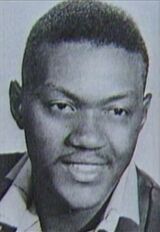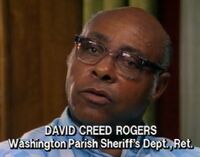
O'Neal Moore
Real Name: O'Neal Moore
Nicknames: No Known Nicknames
Location: Washington Parish, Louisiana
Date: June 2, 1965

Case[]
Details: During the height of the Civil Rights Movement, the black community in Washington Parish, Louisiana began to push for integration of the sheriff's department. In response, two black deputies were appointed. On June 1, 1964, forty-one-year-old David "Creed" Rogers and thirty-four-year-old O'Neal Moore became the first black law enforcement officers in Washington Parish.
The families of the deputies were excited for them. However, some residents of the community were against black people taking any part in law enforcement. Tragically, one year later, Deputy Sheriff O'Neal Moore was gunned down while on duty in a racially-motivated attack. On June 6, 1965, he was laid to rest, an unheralded martyr of the civil rights struggle. His killers were never identified. His partner, Creed Rogers, lost an eye in the attack, but survived. He hopes that the attackers can still be identified and brought to justice.
At the time, black deputies such as O'Neal and Creed were not allowed to confront white people, much less arrest them. Despite the fact that they were working in a "white world" that barely tolerated their presence, they persevered. They promised themselves that they would not let their community down.
It was the night of June 2, 1965. After a year on duty, O'Neal and Creed had come to expect harassment. As a result, they were not surprised when a pickup truck began to tailgate them. When they got onto Peter's Hill, they noticed a fire on the left side of the road. They made a U-Turn and went to inspect the fire. Looking more closely, they realized that it was a trash fire and was not dangerous. They made another U-Turn and proceeded south on the road.
The pickup truck that they had seen earlier had pulled off to the right side of the road. As they passed the truck, it pulled out and began to follow them. Creed noticed that it was a dark black truck with a white rail and rebel tag on the front. As they continued to drive south, the truck sped up and pulled up next to the deputies. At least two of the occupants of the truck began to fire at the deputies. Both O'Neal and Creed were hit; they lost control and crashed into a tree.
A local resident heard the shots and ran to the crash scene. He found O'Neal dead and Creed badly injured. He stood guard until police arrived. Chief Deputy Sheriff Doyle Holliday arrived a few minutes later. He began an intense investigation that would consume the next several months. As Creed was being taken away in an ambulance, he described the truck to Doyle in precise detail. Using this description, Doyle put an "All Points Bulletin" out on the truck.
About a half hour later, Doyle learned that a truck fitting the description was apprehended in Tylertown, Mississippi. The truck fit the description perfectly, with the exception of the side rails - there were no side rails on it at the time of apprehension. The truck was stopped just twenty miles from the scene of the shooting. The driver was arrested, but was later released on a $25,000 bond. The charges were later dismissed due to lack of evidence.
Suspicion naturally focused on the Ku Klux Klan. However, the local chapter immediately denied any involvement. Racial tensions increased in the area. In Washington Parish, the Sheriff refused to give in to the pressure. O'Neal was replaced by another black deputy. O'Neal's wife Maevella recalled that the shooting didn't really accomplish what the assailants intended, as it did not frighten the remaining black deputies and instead gave them more courage to continue doing their jobs.
Doyle Holliday continued to pursue his investigation. Two weeks after the shooting, the violence came to his home. That evening, after he finished talking to the Sheriff on the phone, he went to the couch to sit with his family. Suddenly, shots were fired into their home. Doyle had his family get down on the floor. He then grabbed his gun and went outside. He fired at the assailant's car as they drove away from the home. He believes that he was attacked to try and scare him and stop investigating. However, he and the others involved in the investigation refused to back down.
The local population refused to cooperate with the FBI or local authorities, despite a $25,000 reward from the Governor of Louisiana. The case was deemed "inactive" in 1967. Doyle believes that people were afraid to come forward because the Ku Klux Klan was too powerful and strong. People were afraid that either they or their families would be targeted and attacked if they came forward.
In June of 1987, the FBI field office in New Orleans was contacted by one informant and received letters from two other anonymous sources. They claimed to identify the people responsible for O'Neal's murder. As a result of this new information, the case was reopened. According to FBI agent Michael Heimbach, one of the letters was very specific on identifying individuals that were within the pickup truck and identifying the getaway route of the truck. The FBI has looked into the three individuals mentioned in the letter. They have interviewed their families and people associated with them.
The FBI currently does not have enough information to make any arrests. However, they do believe that the killers belonged to the Ku Klux Klan.
It has been decades since the fateful night that O'Neal Moore and Creed Rogers took their last ride together. Creed refused to be frightened away from his chosen career. In 1988, he retired as a full captain of the Washington Parish Sheriff's Department. He still wonders about who was responsible for the shooting. He also fears that those responsible are still alive and may want to come back and hurt him. Doyle Holliday notes that those involved are getting older and may want to confess before they die.
O'Neal Moore's loved ones still hope that the case will one day be solved.
Suspects: The killers' vehicle was described as a dark-colored (possibly black) pickup truck with white rails and a rebel tag on the front. There is no description available for the shooters.
There are several suspects in the case, but the investigators have not revealed the identities of the men. The Ku Klux Klan is suspected in the case. Several informants confirmed that the local Klan was involved.
Extra Notes: This segment originally aired on the November 14, 1990 episode of Unsolved Mysteries.
Results: Unresolved. In 2001, the case was reopened again. In 2009, the case was re-opened by the Civil Rights-era Cold Case Initiative.
The prime suspect in the case (who was not identified in the segment) was Ernest Ray McElveen, a known white supremacist. He was the man who was arrested on the night of the murder driving a truck that matched the description of the assailant's vehicle. In 2003, he died without ever being charged in the case.
In 2016, the Civil Rights Division of the United States Department of Justice recommended that the case be closed due to the passage of time and the fact that most witnesses and possible suspects in the case are deceased.
Sadly, Doyle Holliday passed away in 1998, and David "Creed" Rogers passed away in 2007.
Links:
- O'Neal Moore at Unsolved.com
- O'Neal Moore on Wikipedia
- Officer Down Memorial Page
- Suspect In Killing Waives Extradition
- Bogalusa Murder Suspects Bonded
- A new climate, a new call for justice
- Decades later, racist crime remains unsolved
- Answers Elusive in 1965 Slaying
- Race-hate murder of black deputy reopened after 37 years
- FBI reopens file on race hate murders
- David Creed Rogers, 84; deputy shot in suspected racist attack in 1965
- Deputy sheriff's murder still unsolved
- Chasing Ghosts In a Civil Rights Era Cop Killing
- Washington Parish Community Remembers Deputy Slain 50 Years Ago
- David Creed Rogers, O'Neal Moore - Notice to Close File
- O'Neal Moore and David "Creed" Rogers at Find a Grave
